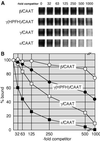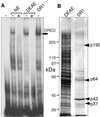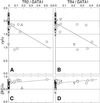An embryonic/fetal beta-type globin gene repressor contains a nuclear receptor TR2/TR4 heterodimer
- PMID: 12093744
- PMCID: PMC126089
- DOI: 10.1093/emboj/cdf340
An embryonic/fetal beta-type globin gene repressor contains a nuclear receptor TR2/TR4 heterodimer
Abstract
We recently described an erythroid epsilon-globin gene repressor activity, which we named DRED (direct repeat erythroid-definitive). We show that DRED binds with high affinity to DR1 sites in the human embryonic (epsilon-) and fetal (gamma-) globin gene promoters, but the adult beta-globin promoter has no DR1 element. DRED is a 540 kDa complex; sequence determination showed that it contains the nuclear orphan receptors TR2 and TR4. TR2 and TR4 form a heterodimer that binds to the epsilon and gamma promoter DR1 sites. One mutation in a DR1 site causes elevated gamma-globin transcription in human HPFH (hereditary persistence of fetal hemoglobin) syndrome, and we show that this mutation reduces TR2/TR4 binding in vitro. The two receptor mRNAs are expressed at all stages of murine and human erythropoiesis; their forced transgenic expression reduces endogenous embryonic epsilony-globin transcription. These data suggest that TR2/TR4 forms the core of a larger DRED complex that represses embryonic and fetal globin transcription in definitive erythroid cells, and therefore that inhibition of its activity might be an attractive intervention point for treating sickle cell anemia.
Figures







Similar articles
-
Embryonic and fetal beta-globin gene repression by the orphan nuclear receptors, TR2 and TR4.EMBO J. 2007 May 2;26(9):2295-306. doi: 10.1038/sj.emboj.7601676. Epub 2007 Apr 12. EMBO J. 2007. PMID: 17431400 Free PMC article.
-
Compound loss of function of nuclear receptors Tr2 and Tr4 leads to induction of murine embryonic β-type globin genes.Blood. 2015 Feb 26;125(9):1477-87. doi: 10.1182/blood-2014-10-605022. Epub 2015 Jan 5. Blood. 2015. PMID: 25561507 Free PMC article.
-
Nuclear receptors TR2 and TR4 recruit multiple epigenetic transcriptional corepressors that associate specifically with the embryonic β-type globin promoters in differentiated adult erythroid cells.Mol Cell Biol. 2011 Aug;31(16):3298-311. doi: 10.1128/MCB.05310-11. Epub 2011 Jun 13. Mol Cell Biol. 2011. PMID: 21670149 Free PMC article.
-
Orphan Nuclear Receptors TR2 and TR4 in Erythropoiesis: From Mechanisms to Therapies.Biomolecules. 2025 May 31;15(6):798. doi: 10.3390/biom15060798. Biomolecules. 2025. PMID: 40563438 Free PMC article. Review.
-
Role of intergenic human gamma-delta-globin sequences in human hemoglobin switching and reactivation of fetal hemoglobin in adult erythroid cells.Ann N Y Acad Sci. 2005;1054:48-54. doi: 10.1196/annals.1345.057. Ann N Y Acad Sci. 2005. PMID: 16339651 Review.
Cited by
-
Identification and characterization of a novel murine allele of Tmprss6.Haematologica. 2013 Jun;98(6):854-61. doi: 10.3324/haematol.2012.074617. Epub 2013 Jan 8. Haematologica. 2013. PMID: 23300183 Free PMC article.
-
Physiological and Aberrant γ-Globin Transcription During Development.Front Cell Dev Biol. 2021 Apr 1;9:640060. doi: 10.3389/fcell.2021.640060. eCollection 2021. Front Cell Dev Biol. 2021. PMID: 33869190 Free PMC article. Review.
-
BAP1 regulation of the key adaptor protein NCoR1 is critical for γ-globin gene repression.Genes Dev. 2018 Dec 1;32(23-24):1537-1549. doi: 10.1101/gad.318436.118. Epub 2018 Nov 21. Genes Dev. 2018. PMID: 30463901 Free PMC article.
-
An international effort to cure a global health problem: A report on the 19th Hemoglobin Switching Conference.Exp Hematol. 2015 Oct;43(10):821-37. doi: 10.1016/j.exphem.2015.06.008. Epub 2015 Jul 2. Exp Hematol. 2015. PMID: 26143582 Free PMC article. Review.
-
Lysine-specific demethylase 1 is a therapeutic target for fetal hemoglobin induction.Nat Med. 2013 Mar;19(3):291-4. doi: 10.1038/nm.3101. Epub 2013 Feb 17. Nat Med. 2013. PMID: 23416702 Free PMC article.
References
-
- Ayer D.E., Lawrence,Q.A. and Eisenman,R.N. (1995) Mad-Max transcriptional repression is mediated by ternary complex formation with mammalian homologs of yeast repressor Sin3. Cell, 80, 767–776. - PubMed
-
- Barberis A., Superti-Furga,G. and Busslinger,M. (1987) Mutually exclusive interaction of the CCAAT-binding factor and of a displacement protein with overlapping sequences of a histone promoter. Cell, 50, 347–359. - PubMed
-
- Behe M.J. and Englander,S.W. (1979) Mixed gelation theory. Kinetics, equilibrium and gel incorporation in sickle hemoglobin mixtures. J. Mol. Biol., 133, 137–160. - PubMed
-
- Chang C. and Kokontis,J. (1988) Identification of a new member of the steroid receptor super-family by cloning and sequence analysis. Biochem. Biophys. Res. Commun., 155, 971–977. - PubMed
Publication types
MeSH terms
Substances
Grants and funding
LinkOut - more resources
Full Text Sources
Other Literature Sources
Molecular Biology Databases
Research Materials

